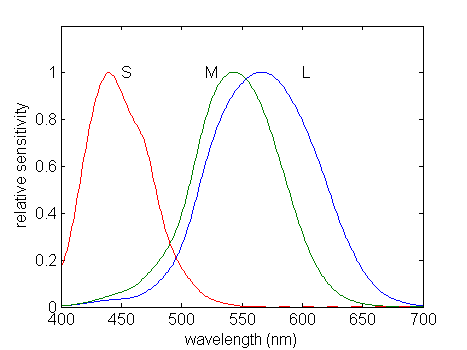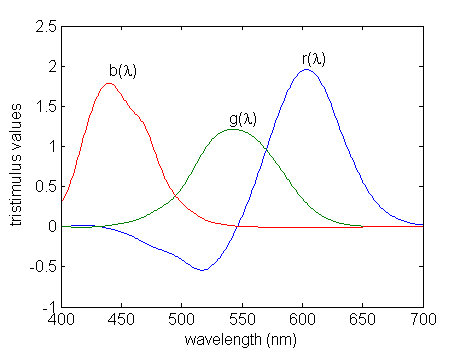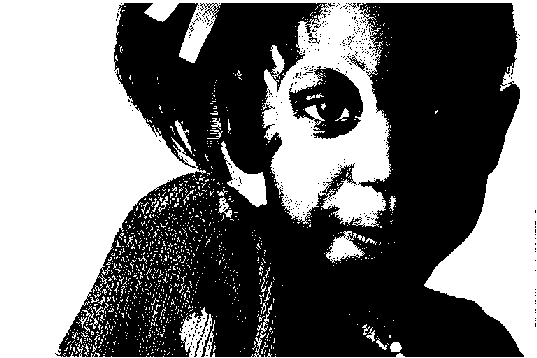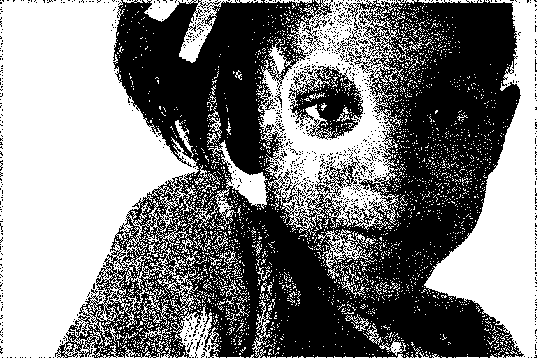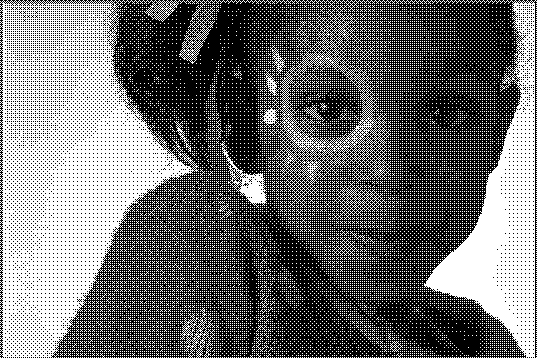Color is a perceptual phenomenon related to the human response to
different wavelengths of light, mainly in the region of 400 to 700
nanometers (nm).
The perception of color arises from the sensitivities of three types of
neurochemical sensors in the retina, known as the long (L),
medium (M), and short (S) cones.
The response of these sensors to photons
is shown in Figure 17.1.
Note that each sensor responds to a range of wavelengths.
Due to this property of the human visual system, all colors can be modeled as
combinations of the three primary color components: red (R), green (G),
and blue (B).
For the purpose of standardization, the CIE (Commission
International de l'Eclairage — the International Commission on Illumination)
designated the following wavelength values for the
three primary colors: blue = 435.8nm, green = 546.1nm, and
red = 700nm.
The relative
amounts of the three primary colors of light required to produce a color
of a given wavelength are called tristimulus values.
Figure 17.2 shows the
plot of tristimulus values using the CIE primary colors.
Notice that some of the tristimulus values are negative, which
indicates that colors at those
wavelengths cannot be reproduced by the CIE primary colors.
Download the files
girl.tif and ycbcr.mat.
For help on image command select the link.
You will be displaying both color and monochrome images in the following
exercises.
Matlab's image command can be used for both image types, but
care must be taken for the command to work properly.
Please see the
help on the image command
for details.
Download the RGB color image file
girl.tif
,
and load it into Matlab using the imread command.
Check the size of the Matlab array for this image by typing whos.
Notice that this is a three dimensional array of type uint8.
It contains three gray scale image planes corresponding to the red, green, and
blue components for each pixel.
Since each color pixel is represented by
three bytes, this is commonly known as a 24-bit image.
Display the color image using
image(A);
axis('image');
where A is the 3-D RGB array.
You can extract each of the color components using the following commands.
RGB = imread('girl.tif'); % color image is loaded into matrix RGB
R = RGB(:,:,1); % extract red component from RGB
G = RGB(:,:,2); % extract green component from RGB
B = RGB(:,:,3); % extract blue component from RGB
Use the subplot and image commands
to plot the original image, along with each of the three color components.
Note that while the original is a color image, each color component
separately is a monochrome image.
Use the syntax subplot(2,2,n)
, where n=1,2,3,4, to place the four
images in the same figure.
Place a title on each of the images, and print the figure
(use a color printer).
We will now examine the YCbCr color space representation.
Download the file
ycbcr.mat
,
and load it into
Matlab using load ycbcr.
This file contains a Matlab array for a color image in YCbCr format.
The array contains
three gray scale image planes that correspond to the luminance (Y) and
two chrominance (CbCr) components.
Use subplot(3,1,n)
and image to display each of the components
in the same figure.
Place a title on each of the three monochrome images, and print the figure.
In order to properly display this color image,
we need to convert it to RGB format.
Write a Matlab function that will perform the transformation of
Equation 17.2.
It should accept a 3-D YCbCr image array as
input, and return a 3-D RGB image array.
Now, convert the ycbcr array to an RGB representation and
display the color image.
Remember to convert the result to type uint8 before using
the image command.
An interesting property of the human visual system, with respect to
the YCbCr color space, is that we are much more
sensitive to distortion in the luminance component than in the chrominance
components. To illustrate this, we will smooth each of these components
with a Gaussian filter and view the results.
You may have noticed when you loaded ycbcr.mat into Matlab that you
also loaded a 5×5 matrix, h. This is a
5×5 Gaussian filter with σ2=2.0.
(See the first week of the experiment for more details on this type of
filter.)
Alter the ycbcr array by filtering only the luminance component,
ycbcr(:,:,1)
,
using the Gaussian filter (use the filter2 function).
Convert the result to RGB, and display it using image.
Now alter ycbcr by filtering both chrominance components,
ycbcr(:,:,2) and ycbcr(:,:,3), using the Gaussian filter.
Convert this result to RGB, and display it using image.
Use subplot(3,1,n)
to place the original and two filtered versions
of the ycbcr image in the same figure.
Place a title on each of the images, and print the figure (in color).
Do you see a significant difference between the filtered versions and
the original image?
This is the reason that YCbCr is often used for digital video. Since
we are not very sensitive to corruption of the chrominance components, we
can afford to lose some information in the encoding process.
INLAB REPORT
Submit the figure containing the components of girl.tif.
Submit the figure containing the components of ycbcr.
Submit your code for the transformation from YCbCr to RGB.
Submit the figure containing the original and filtered versions
of ycbcr. Comment on the result of filtering the luminance
and chrominance components of this image. Based on this,
what conclusion can you draw about the human visual system?




